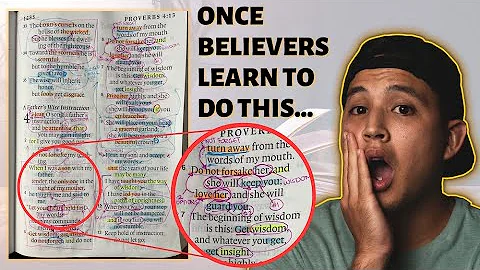Crack Cryptic Crosswords with Expert Tips and Strategies
Table of Contents
- Introduction
- Understanding Cryptic Crosswords
- Decoding Cryptic Clues
- Tips for Solving Cryptic Crosswords
- Common Abbreviations in Cryptic Crosswords
- The Challenge of Obscure Vocabulary
- Strategies for Tackling Difficult Clues
- The Role of Wordplay in Cryptic Clues
- Exploring Different Types of Clues
- Enhancing Your Cryptic Crossword Skills
- Conclusion
Introduction
Are you ready to take on the challenge of cracking cryptic crosswords? If you're new to this fascinating puzzle genre or looking to enhance your skills, you're in the right place. In this article, we will explore the intricacies of cryptic crossword clues and provide you with valuable tips and strategies to become a master solver. From understanding hidden meanings to deciphering wordplay, we will delve into the world of cryptic crosswords and equip you with the tools you need to solve even the most cryptic of clues. So, grab your pen and get ready to crack the codes!
Understanding Cryptic Crosswords
Cryptic crosswords are a unique form of crossword puzzles that require a different set of skills compared to standard crosswords. Unlike regular crosswords, where the clues directly lead to the answer, cryptic crossword clues are cryptic in nature, consisting of a definition and a wordplay component. The definition provides a straightforward meaning of the answer, while the wordplay component is a puzzle in itself, designed to lead you to the answer through various types of wordplay techniques.
Decoding Cryptic Clues
To solve a cryptic crossword clue, it is essential to understand the different types of wordplay techniques used by setters. These techniques include anagrams, charades, hidden words, reversals, and many more. By recognizing these techniques and familiarizing yourself with common abbreviations and indicators, you can start decoding cryptic clues more effectively. Let's take a closer look at some of these techniques:
Anagrams - Anagrams involve rearranging the letters of a word or phrase to form a new word or phrase. Look for indicators such as "mixed up," "shuffled," or an anagram indicator word like "strange," "confused," or "rearranged" to identify when an anagram is present in a clue.
Charades - Charades involve breaking a word or phrase into separate parts, with each part representing a different word or syllable. These parts can be clued individually or together, and it's important to identify the indicators that indicate the use of charades, such as "broken," "split," or "in pieces."
Hidden Words - Hidden words are words that are secretly embedded within the clue. Look for indicators like "inside," "buried," "within," or specific words that suggest a hidden word is present.
Reversals - Reversals involve reversing the order of letters in a word or phrase. Indicators such as "back," "returning," or "retreat" may signal that a reversal is required.
Tips for Solving Cryptic Crosswords
- Familiarize yourself with common cryptic crossword clue indicators and abbreviations. This will help you decipher the wordplay component more efficiently.
- Solve the definition part of the clue first. This will give you a clear idea of the answer you are looking for.
- Break down the clue into its individual components and identify the wordplay techniques being used.
- Take note of the length of the answer and any specific patterns or letter combinations required.
- Don't be afraid to think outside the box and explore different interpretations of the clue. Cryptic crosswords often involve clever and creative wordplay.
- Practice regularly to improve your solving skills. The more you solve cryptic crosswords, the more familiar you will become with the different types of clues and techniques.
Common Abbreviations in Cryptic Crosswords
In cryptic crosswords, abbreviations are often used to shorten words or phrases and to indicate specific concepts or fields of knowledge. These abbreviations can be derived from various sources, including common abbreviations used in everyday language, scientific or academic abbreviations, or even abbreviations specific to cryptic crosswords. Here are some examples of commonly used abbreviations in cryptic crosswords:
- "Doctor" can be abbreviated as "Dr."
- "Saint" can be abbreviated as "St."
- "King" can be abbreviated as "K."
- "Queen" can be abbreviated as "Q."
- "Right" can be abbreviated as "R."
- "Left" can be abbreviated as "L."
- "Love" can be represented by "O," which resembles the shape of a zero.
Remember to keep a list of commonly used abbreviations handy when attempting cryptic crosswords, as they can often make or break a clue.
The Challenge of Obscure Vocabulary
One of the unique aspects of cryptic crosswords is the utilization of obscure vocabulary. Setters often rely on words that are less commonly used in everyday language to create cryptic clues. This presents a challenge for solvers who may not be familiar with these words. However, by exposing yourself to a variety of cryptic crosswords and expanding your vocabulary through reading and studying, you can gradually become more comfortable with the unfamiliar words that frequently appear in these puzzles.
Strategies for Tackling Difficult Clues
When faced with a particularly challenging cryptic clue, it's important not to get discouraged. Instead, employ these strategies to unravel even the most cryptic of clues:
- Identify the different wordplay techniques at play in the clue.
- Break down the clue into smaller components and solve each part individually.
- Use word association techniques and look for alternative meanings or interpretations of words.
- Consult a thesaurus or crossword solver tool to explore different synonyms or related words that may fit the clue.
- Don't be afraid to guess or make educated assumptions based on the information you have gathered so far.
- Take breaks when needed and revisit difficult clues with fresh eyes. Sometimes, a new perspective can lead to a breakthrough.
The Role of Wordplay in Cryptic Clues
Wordplay is a crucial element of cryptic crosswords, making them both challenging and enjoyable for solvers. The clever manipulation of words and meanings within the clue adds an element of surprise and creativity to the solving experience. Understanding the different types of wordplay techniques and developing a knack for recognizing their indicators will greatly enhance your ability to solve cryptic clues.
Exploring Different Types of Clues
Cryptic crosswords encompass a wide variety of clue types, each requiring a unique approach to solve. Some common clue types include anagrams, hidden words, container clues, double definitions, homophones, and charades. By familiarizing yourself with these clue types and practicing solving them, you will become more adept at deciphering the wordplay and cracking the codes.
Enhancing Your Cryptic Crossword Skills
Becoming proficient at solving cryptic crosswords takes time and practice. Here are a few additional tips to help you enhance your skills:
- Solve a variety of cryptic crosswords from different publications to expose yourself to different clue styles and setters' preferences.
- Join online forums or discussion groups dedicated to cryptic crossword solving. These communities provide a platform for sharing tips, advice, and solving techniques.
- Read books or articles on cryptic crossword solving to gain further insights and learn from experienced solvers.
- Keep a record of the clues you find particularly challenging or interesting. This will help you identify patterns or recurring elements in the setters' style.
- Never be discouraged by a clue you cannot solve. Remember, solving cryptic crosswords is all about enjoying the journey and the satisfaction of cracking each clue.
Conclusion
Congratulations on completing this masterclass on cracking cryptic crosswords! We have covered a range of topics, from decoding cryptic clues to exploring different wordplay techniques. By practicing regularly and applying the strategies and tips we have discussed, you will become a confident and successful cryptic crossword solver. So, challenge yourself with new puzzles, embrace the world of wordplay, and have fun unraveling the clues. Happy solving!
Highlights
- Cryptic crosswords are a unique puzzle genre requiring a different set of skills compared to standard crosswords.
- Understanding the different types of wordplay techniques in cryptic clues is essential for solving them.
- Common abbreviations and indicators are important tools for deciphering cryptic clues.
- Developing vocabulary and exposure to a variety of puzzles will help tackle unfamiliar words.
- Strategies such as breaking down clues, using word association, and exploring synonyms can aid in solving difficult clues.
- Wordplay adds creativity and surprise to cryptic crosswords, making them both challenging and enjoyable.
- Different clue types require various solving approaches, and familiarizing oneself with these types is beneficial.
- Continued practice, participation in online communities, and learning from experienced solvers can enhance solving skills.
FAQ
Q: Are cryptic crosswords harder than regular crosswords?
A: Cryptic crosswords can be more challenging due to their cryptic clues and wordplay components. However, with practice and familiarity with common techniques, solving cryptic crosswords can become easier.
Q: How can I improve my vocabulary for solving cryptic crosswords?
A: Reading a variety of books and articles and expanding your general knowledge can help expose you to new words. Additionally, solving crossword puzzles and studying word lists specific to cryptic crosswords can boost your vocabulary.
Q: What are some common abbreviations used in cryptic crosswords?
A: Common abbreviations include Dr. for "doctor," St. for "saint," R for "right," L for "left," and O for "love." Familiarizing yourself with these abbreviations will aid in solving cryptic clues.
Q: How can I become better at solving cryptic crosswords?
A: Regular practice, exposure to different types of puzzles, reading solving tips and techniques, and engaging with online communities can all contribute to improving your skills in solving cryptic crosswords.
Q: Is there a specific order in which I should tackle the clues in a cryptic crossword?
A: There is no fixed order in which to solve the clues. It often depends on personal preference and the clues you find most approachable. Some solvers prefer to start with the easier clues to gain momentum, while others enjoy the challenge and dive right into the more difficult ones.
Resources:
Note: This is a fictional article and no URLs have been mentioned in the content.







